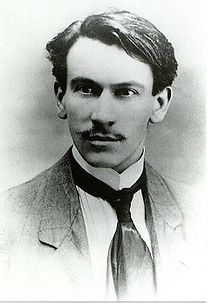Louis Pergaud
Louis Émile Pergaud (born January 22, 1882 in Belmont , Doubs department , † April 8, 1915 in Marchéville-en-Woëvre , Meuse department ) was a French writer .
Life and work
Louis Pergaud grew up in his birthplace Belmont near Besançon as the second child of a village schoolmaster and a farmer's daughter. A first brother, Pierre (August 9, 1880 - October 5, 1880), had died as an infant, a younger brother, Lucien (1883–1973) survived him by almost 60 years. At 16 (1898), Pergaud passed the entrance exam for the teachers' seminar in Besançon with splendor, which he left in 1901, also with very good marks. Then, at just 19, he became a village school teacher in Durnes (Dép. Doubs). A year later he was drafted into the military in Belfort , since his training at the seminary had given him high school diploma, for a shortened one-year service. Then (1903) he was again a teacher in Durnes and married Marthe Caffot, a colleague from the neighboring village of La Barèche, when he was just 21 (he had lost his parents in quick succession at the age of 18) .
In the meantime he had begun to write, initially poetry, as was customary with young authors at the time. In 1904 he had them appear collectively under the title L'Aube ( The Dawn ), supported by the little older Belfort friend and poet colleague Léon Deubel .
When church and state separated in France in 1905 and the primary school system was reorganized, i. H. was usually laicized , Pergaud was transferred to another village in the department, Landresse . Here his refusal to teach in the spirit of the Catholic Church and also to demonstrate piety in private, brought him into conflict with the dignitaries of the village.
After he had apparently grown apart quickly with his wife, but had confirmed his image of himself as an author through a next volume of poetry, L'Herbe d'avril ( Aprilgrün , 1906), he quit school in 1907 and went to Paris, followed by his new partner Delphine Duboz (whom he married in 1910 after their divorce in 1908).
In Paris he worked first as a typist and then again as a teacher. Above all, however, he wrote, and since his poetry volumes had not met with any appreciable echo, he wrote almost exclusively as a narrator in a style committed to naturalism .
He achieved his breakthrough in 1910 with the eight mostly tragic animal stories in the volume De Goupil à Margot (= Vom [Fox] Goupil to [Elster] Margot ). Her idiosyncratic macabre realism earned him the prestigious Prix Goncourt . In 1911 he followed in a similar manner La Revanche du corbeau ( The Raven's Revenge ), in 1913 Le Roman de Miraut, chien de chasse ( The novel about the hound Miraut ).
In between, in 1912, his work, which is still known today, came out: La Guerre des boutons, roman de ma douzième année ( The button war. A novel from the age of 12 ). The novel, set in Pergaud's home province, depicts with a lot of superficial wit and profound seriousness the grotesquely macabre "war" of the boys in two neighboring villages who cut the buttons of the defeated to humiliate them and for their own enrichment (which is why the title actually starts with Der Krieg um the buttons would have to be translated). La Guerre des boutons not only addresses the general human tendency to war and violence, but also specifically the tensions between the clerical and the secular camp in France at the time.
The novel has had more than 30 editions until recently. It was filmed several times, in 1936 and 1962, and in 1994 in an English version. The version The War of Buttons (1962) by director Yves Robert even achieved cult film status. In 2011, almost a hundred years after the novel was published, two more films were released in France, practically simultaneously, shot by Yann Samuell and Christophe Barratier. The latter is quite clear with the template around and called his version as well as La nouvelle guerre des boutons ( the new War of the Buttons ).
Pergaud was drafted at the beginning of the First World War in August 1914. In the trench warfare on the stalled German-French front, he was in an unsuccessful attempt to attack his company wounded, apparently salvaged by German soldiers and a military hospital managed, but there shortly afterwards with a surface bombardment by French artillery killed.
A few more stories about animals and people in the ambience of the author's rural home region appeared posthumously.
His memory is cherished by a literary association based in Paris: Les Amis de Louis Pergaud .
literature
- Jean-Pierre de Beaumarchais, Daniel Couty, Alain Ray: Dictionnaire des littératures en langue française , 4 vols., Paris: Bordas, 1994 (Pergaud article)
- Jean-Pierre de Beaumarchais, Daniel Couty, Dictionnaire des œuvres littéraires de langue française , 4 vols., Paris: Bordas, 1994 (articles La Guerre des boutons and De Goupil à Margot )
- See also the articles on Pergaud in the French and English Wikipedia
Web links
- Literature by and about Louis Pergaud in the catalog of the German National Library
- Gert Pinkernell, article in the name, title and dates of the French Literature (main source)
| personal data | |
|---|---|
| SURNAME | Pergaud, Louis |
| ALTERNATIVE NAMES | Pergaud, Louis Émile |
| BRIEF DESCRIPTION | French author |
| DATE OF BIRTH | January 22, 1882 |
| PLACE OF BIRTH | Belmont |
| DATE OF DEATH | April 8, 1915 |
| Place of death | Marchéville-en-Woëvre |

